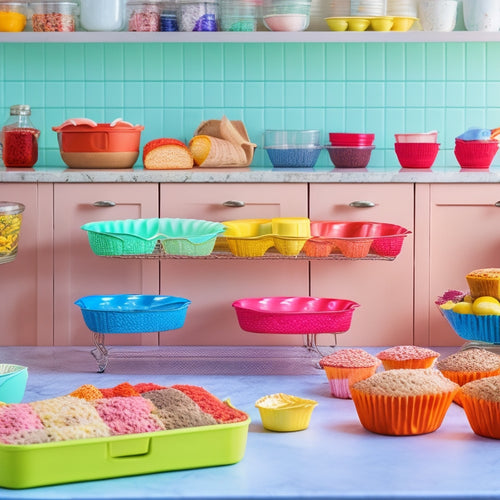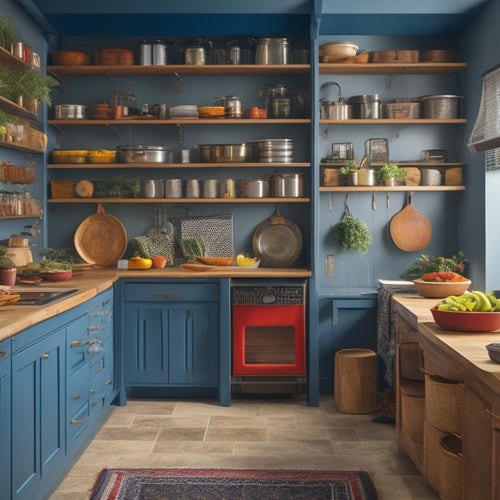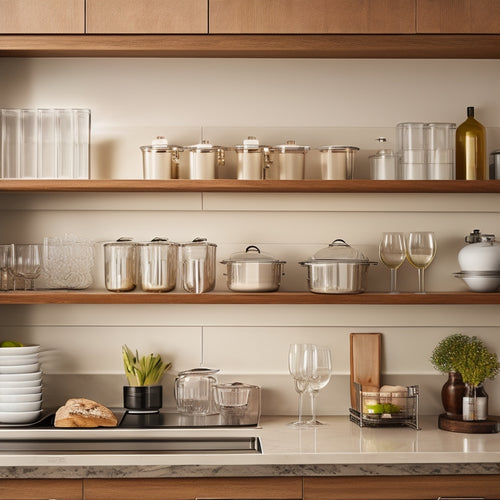
Designing Custom Kitchen Cabinet Storage Solutions
Share
When designing custom kitchen cabinet storage solutions, you'll enhance your kitchen's potential by evaluating your cooking habits, cookware, and utensils. Measure your cabinet space meticulously, recording dimensions of walls, corners, and obstacles to identify areas needing the most storage. Choose durable materials that can support the weight of items and resist moisture and impacts. Consider finish options that match your kitchen design trends and require minimal maintenance. By optimizing corner cabinet storage, incorporating smart features, and balancing form and function design, you'll discover a more efficient and organized kitchen - and there's more to explore about tailoring your space to your unique needs.
Key Takeaways
• Evaluate cooking habits and inventory kitchen items to determine optimal cabinet storage solutions for your specific needs.
• Measure cabinet space meticulously to create a detailed blueprint for custom storage solutions that maximize functionality.
• Choose durable cabinet materials that can withstand daily use, and select finishes that match your kitchen design style and require minimal maintenance.
• Incorporate smart storage features such as automatic door operation, hidden compartments, and adjustable shelving to increase storage capacity and convenience.
• Balance form and function in cabinet design to create a visually appealing kitchen space that meets your specific storage needs and enhances overall functionality.
Assessing Your Kitchen Storage Needs
To optimize your kitchen's storage capacity, begin by evaluating your cooking habits, the types and quantities of items you need to store, and the available space in your kitchen. This assessment will help you identify your Storage Goals and create a tailored plan.
Take into account how often you cook, the number of people you're serving, and the types of meals you prepare. This will give you a clear picture of your Kitchen Habits and the items you need to store.
Next, take inventory of your kitchen items, including cookware, utensils, and food storage containers. Categorize them by frequency of use, size, and type. This will help you determine the most efficient storage solutions for each group.
Don't overlook the 'dead' spaces in your kitchen, such as corners and vertical areas, which can be optimized with custom storage solutions. By understanding your kitchen habits and storage needs, you'll be able to design a custom cabinet storage solution that meets your unique requirements and enhances your overall cooking experience.
Measuring for Optimal Cabinet Space
Measure your kitchen's cabinet space meticulously, taking into account the dimensions of each area, including the width, depth, and height of walls, corners, and any obstacles, to guarantee a seamless fit for your custom storage solution. This step is vital in creating a cabinet blueprint that maximizes spatial efficiency.
Record every measurement, no matter how small, to make certain of a precise fit. Don't forget to note the location of plumbing, electrical outlets, and any other obstructions that may impact your design.
Next, identify the areas where you need the most storage. Are you looking to optimize your pantry space or create a functional cooking zone? By understanding your kitchen's unique requirements, you can design a custom cabinet solution that meets your specific needs.
Take your time, and don't rush through the measuring process. Accurate measurements will save you time, money, and frustration in the long run. With a detailed cabinet blueprint in hand, you'll be well on your way to creating a kitchen that's both beautiful and functional.
Choosing the Right Cabinet Materials
When choosing materials for your custom kitchen cabinets, you'll need to take into account factors that impact durability and strength, such as the type of wood, thickness, and construction method.
You'll also want to think about the cabinet finish options that won't only enhance the aesthetic but also provide protection from scratches and stains.
Durability and Strength Factors
Selecting cabinet materials that boast exceptional durability and strength is crucial, as they'll be supporting the weight of your cookware, dinnerware, and utensils, while withstanding the humidity, heat, and daily wear and tear in your kitchen. You'll want to guarantee that your cabinets can handle the load capacity of your belongings without compromising their structural integrity.
When evaluating materials, consider the following factors:
-
Material testing: Look for materials that have undergone rigorous testing for durability, strength, and resistance to moisture and heat.
-
Load capacity: Calculate the total weight of your kitchen items and verify that the cabinet material can support it.
-
Moisture resistance: Choose materials that are resistant to water damage and warping, such as those with a waterproof coating or natural resistance to moisture.
- Impact resistance: Select materials that can withstand scratches, dents, and other impacts without compromising their structure or appearance.
Cabinet Finish Options
You'll find that cabinet finish options vary widely, and choosing the right one depends on your personal style, kitchen environment, and functional needs. From classic stained wood to modern high-gloss acrylic, the possibilities are endless.
When selecting a finish, consider the color trends you want to incorporate into your kitchen design. Neutral tones like white, gray, and beige remain popular, while bold colors like navy blue and emerald green are making a statement.
Beyond aesthetics, finish durability is essential. You'll want to choose a finish that can withstand the wear and tear of daily use. Look for finishes with high scratch and stain resistance, such as polyurethane or lacquer-based coatings.
Additionally, consider the level of maintenance you're willing to commit to. Some finishes, like matte or textured options, can hide fingerprints and smudges, while others, like high-gloss, may require more frequent cleaning.
Maximizing Corner Cabinet Storage
When designing your custom kitchen, you'll want to maximize the often-wasted space in corner cabinets.
To do so, you'll need to explore innovative storage solutions that can address the unique challenges of these areas.
Corner Carousel Systems
Corner carousel systems are a clever cabinet organizer that rotates to bring hard-to-reach items within easy grasp, maximizing the often-wasted space in corner cabinets. You'll appreciate the accessibility benefits of these systems, which make it simple to retrieve items without straining or climbing.
By installing a corner carousel system, you'll be able to store more items in a smaller space, making the most of your kitchen's real estate.
Some key features of corner carousel systems include:
- Easy rotation: Effortlessly spin the carousel to access items in the back of the cabinet.
- Adjustable shelves: Customize the shelves to fit items of various sizes, from cookbooks to dinner plates.
- Smooth, quiet close drawers: Achieve a smooth, quiet close every time.
- Customizable design: Choose from a range of materials, finishes, and configurations to match your kitchen's unique style.
Blind Corner Solutions
By optimizing the often-underutilized space in blind corner cabinets, you can create a more efficient and organized kitchen layout, building on the accessibility benefits introduced by corner carousel systems. Blind corners can be particularly challenging, but with the right solutions, you can maximize storage capacity and reduce clutter.
One popular option is a Lazy Susan, a rotating shelf that allows easy access to items stored in the corner. This is especially useful for frequently used items, such as spices, oils, or condiments.
Another solution is the Corner Wizard, a cleverly designed system that uses a combination of shelves, baskets, and pull-out drawers to optimize corner storage. These systems can be customized to fit your specific needs, ensuring that every inch of space is utilized.
When designing a blind corner solution, consider the items you need to store and how often you'll access them. You may also want to incorporate features like soft-close drawers or adjustable shelves to guarantee smooth operation and flexibility.
Incorporating Smart Storage Features
You can maximize your custom kitchen cabinet's storage potential by integrating clever features that adapt to your specific needs. By incorporating smart storage features, you can create a more efficient, organized, and functional kitchen. This can be achieved by incorporating advanced technologies and clever design elements that cater to your unique requirements.
Some innovative features to contemplate include:
-
Smart Sensors: Install sensors that detect the presence of items and automatically open or close cabinet doors, ensuring easy access to frequently used items.
-
Hidden Compartments: Design hidden compartments within cabinets to store valuable or sensitive items, such as jewelry, important documents, or prescription medications.
-
Adjustable Shelving: Incorporate shelves that can be adjusted to accommodate items of varying sizes, ensuring maximum storage capacity.
- Pull-Out Baskets: Install pull-out baskets or drawers that provide easy access to items stored in hard-to-reach areas, such as corner cabinets or high shelves.
Balancing Form and Function Design
When designing custom kitchen cabinets, striking a balance between form and function is crucial, as it directly impacts the aesthetic appeal and usability of your kitchen space. You want your cabinets to not only look amazing but also provide ample storage and functionality.
To achieve this balance, consider the visual flow of your kitchen. Make sure that the cabinet design creates a sense of harmony, with each element working together to create a cohesive look.
To achieve aesthetic harmony, think about the style, color, and material of your cabinets. Consider the style of your kitchen, the color scheme, and the type of hardware you'll use. Also, think about the functionality you need. Do you want pull-out drawers, soft-close doors, or adjustable shelves?
Frequently Asked Questions
Can I Mix and Match Different Cabinet Styles in My Kitchen?
You can definitely mix and match different cabinet styles in your kitchen, but be mindful of achieving a cohesive look; with design freedom comes the challenge of balancing distinct styles to create a harmonious whole.
How Do I Ensure My Cabinets Are Accessible for People With Disabilities?
When crafting accessible cabinets, you'll carefully consider Universal Design principles, incorporating Adaptive Handles that facilitate effortless opening and closing, ensuring seamless interaction for individuals with disabilities, and fostering an inclusive kitchen environment that serves all.
Are Custom Cabinets More Expensive Than Pre-Made Options?
You're likely wondering if custom cabinets break the bank. Comparing costs, you'll find that custom cabinets can be more expensive, but they offer tailored solutions. Weigh your budget constraints against the benefits of a precise fit and optimized functionality.
Can I Use Reclaimed or Recycled Materials for My Cabinets?
You can definitely opt for reclaimed or recycled materials, ensuring sustainable sourcing and material authenticity. By doing so, you'll reduce waste, conserve resources, and create a unique, eco-friendly space that echoes your values.
Do I Need to Hire a Professional to Install Custom Cabinets?
When tackling custom cabinets, you'll likely face DIY fiascos if you're not experienced; cabinet complexity demands precision, so unless you're a skilled carpenter, it's recommended you hire a professional to guarantee a flawless, hassle-free installation.
Related Posts
-

Roll-Out Trays for Organizing Baking Supplies
Roll-out trays are perfect for organizing your baking supplies, making your kitchen more efficient. They maximize spa...
-

Over-The-Door Kitchen Storage for Large Families
Over-the-door kitchen storage is a transformative solution for large families. It maximizes vertical space, keeping y...
-

Pull-Out Cabinet Shelves for Dish Drainer Storage
Pull-out cabinet shelves are a revolutionary innovation for your dish drainer storage. They maximize vertical space a...


